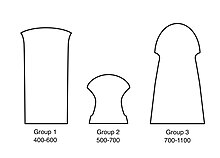Picture stones of Smiss (Parish När)
The picture stones from Smiss in the parish of När on the Swedish island of Gotland fall at the end of the middle period of the three picture stone epochs . One specimen still shows the typical animal motifs, while the second already shows a ship and a duel, which belong to the motifs of the stones of type 3.
Between 500 and 700 AD, the first style of picture stone arose on Gotland, using representational elements, with stones of the so-called type 2. The drawings were no longer exclusively geometrical, as before, not completely pictorial as after, and not flat , but rather scratched as an outline. The stones of the middle epoch are generally small and are therefore called dwarf stones. The two stones from När are slightly higher and belong to the end of the era.
The snake stone
The popular name for the representation on stone 1 of När is "snake witch" or "snake charmer". In the lower part of the picture stone, a woman holds two snakes in her hands, while above her intertwined snakes in the form of a triskele wind. As a symbol of fertility, the snake is widespread in almost all agricultural crops ( Crete ). In the Nordic megalithic architecture it has been documented since the rock carvings of the Bronze Age (see Asperberget, Vitlycke). Undoubtedly, the picture stone, marked by the woman's spread legs, is a fertility myth, which can also be found on simultaneous depictions of the Sheela-na-Gig in Ireland . Otherwise it already shows the marginal knot patterns of the next Gotland picture stone tradition.
Today it is in Gotland's Fornsal in Visby .
The combat stone
With a height of 90 cm, this only slightly phallic stone is still almost one of the "dwarf stones" typical of the era. However, it only shows the motifs of the subsequent Gotland picture stone tradition of type 3.
Type 3 picture stones are among those that show the few depictions of people from the Vendel and Viking ages . There are almost exclusively figures whose bodies, clothes, weapons, shields etc. are not separated by lines. With this method, only the contours are shown. There is therefore a particular controversy with men's clothing. For clothing this means that tight trousers or sleeves do not stand out from the contours, whereas wide trousers and sleeves change the contours. So the question arose: Do the lobed bulges on the arms represent a) the tips of cloaks, b) shields c) tunic sleeves with pointed ends. According to Thunmark-Nylen, only variant c) has a sufficient probability (also when using other image documents) ( see web link).
The head of the picture stone may represent a spar walk , the duel, fought out according to exact rules, which at that time remained in use as a legal basis until the Middle Ages. In the lower part, a sailing ship is shown, on which there are five helmeted crew members. Otherwise the stone shows marginal knot patterns.
The stone is now in the Statens Historiska Museum in Stockholm .
literature
- Erik Nylén , Jan Peder Lamm: Picture stones on Gotland. Wachholtz, Neumünster 1981, 1991 (2nd edition), ISBN 3-529-01823-6 .
Web links
- Bildsteine von Smiss (Parish När) - entry in the database "Fornsök" des Riksantikvarieämbetet (Swedish)
- Theory of the wide-sleeved tunics

